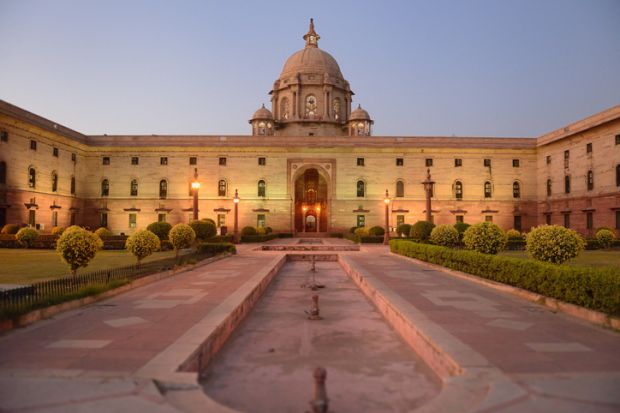India has handed a budget of 500 billion rupees (£5 billion) to its new independent research funder.
The funding for the National Research Foundation (NRF), to be spread over five years, was announced by the finance minister, Nirmala Sitharaman, in the national budget. It will be directed towards “identified national priority thrust areas”, she said.
The NRF, announced last summer as part of India’s new National Education Policy (NEP), is designed to provide competitive research funding and to coordinate grants offered by government agencies.
Meanwhile, “glue grants” will be used to create “umbrella structures” in nine cities, to join up higher education institutions located in the same area. The technology hub of Hyderabad, for example, currently has about 40 such institutions.
Overall, funding for the Department for Higher Education will hold broadly steady at 385 billion rupees.
Sasmita Samanta, pro vice-chancellor of the Kalinga Institute of Industrial Technology, told Times Higher Education that the NRF funding would “indirectly strengthen the research and innovation ecosystem in universities”.
She added that “the Covid-19 pandemic has disrupted a number of existing practices. But it has also helped to explore new opportunities in teaching and research, and eased internationalisation activities by use of information technology and online platforms”.
Internationalisation was highlighted in the budget plans, which include a “regulatory mechanism to permit dual degrees, joint degrees, twinning arrangements and other such mechanisms”.
Eldho Mathews, deputy adviser in the unit for international cooperation at Delhi’s National Institute of Educational Planning and Administration, told THE that “this move signals proactive internationalisation and a liberal regulatory structure for international branch campuses in the coming months”.
The budget advances previous steps to open up India’s higher education market. The NEP unveiled in 2020 made allowances for foreign universities to open branch campuses in India. In January, it was announced that institutes of Eminence, comprising the country’s 20 top universities, would be permitted to open overseas campuses.
Efforts were also made to cut through some of India’s infamous red tape.
Proposed legislation will allow for a Higher Education Commission, which will merge several bodies including the University Grants Commission, an idea that Ms Sitharaman posited in her first budget in 2019-20. “It will be an umbrella body having four separate vehicles for standard-setting, accreditation, regulation, and funding,” she said.
Professor Samanta added that “the consolidation of multiple regular institutions and the establishment of a single regular institution will eliminate multiple reporting practices and facilitate function with more clarity and autonomy”.
Mr Mathews said that the idea of glue grants to link up institutions in cities was “interesting”.
“This will certainly promote synergy between various central research institutions, universities and colleges, which is lacking at the moment,” he said.
Pushkar, director of the International Centre Goa, said that he was “a bit excited” by the “glue grants” idea.
“I have always maintained that for India’s universities to do better in terms of quality education, whether teaching or research, they must be located in or in close proximity to cities,” Dr Pushkar said. “The government has implicitly recognised that select Indian cities are the major education centres and they need to be given more attention.”
Another proposal involves opening a central university in the town of Leh, to bring “accessible education” to the volatile Kashmir region.
For now, the budget increase will not be enough to enact the ambitious NEP, which aims to double the size of the higher education sector in 20 years. Critics are understandably waiting to see if that enormous task can be achieved.
“The taste of the pudding is in the eating,” Dr Pushkar said. “Past experience with many good government initiatives suggests that one has to wait and see what comes of it.”
joyce.lau@timeshighereducation.com
Hear more at the THE India Universities Forum on 10-11 February 2021. Register free here.
Register to continue
Why register?
- Registration is free and only takes a moment
- Once registered, you can read 3 articles a month
- Sign up for our newsletter
Subscribe
Or subscribe for unlimited access to:
- Unlimited access to news, views, insights & reviews
- Digital editions
- Digital access to THE’s university and college rankings analysis
Already registered or a current subscriber? Login







